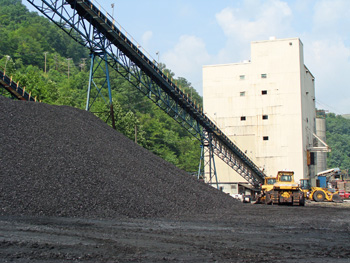

KGS Home > News and Announcements
 Jerry Weisenfluh responds to recent published article on the future of Central Appalachian Coal
Jerry Weisenfluh responds to recent published article on the future of Central Appalachian Coal
The September 27 Associated Press story by Dylan Lovan about the anticipated decline of Central Appalachian coal production paints a bleak picture for the future of coal in that region. According to Lovan, coal production is expected to plummet in the near future, primarily due to depletion of mineable reserves. Lovan cites a 2010 report by McIlmoil and Hansen of Downstream Strategies, an environmental consulting firm in Morgantown, W.Va., as well as other sources. As a geologist who is familiar with coal resources in eastern Kentucky, I wanted to find out more about how McIlmoil and Hansen arrived at these conclusions.
Downstream Strategies primarily used public data compiled by the Energy Information Administration about coal production, coal prices, employment, and mine productivity. Three reasons are cited for the downward trend in Central Appalachian coal production: competition, reserve depletion, and effects of regulation. The AP article would lead us to believe that reserve depletion is overshadowing the other factors. The central argument of the Downstream paper revolves around the relationship between mine productivity and coal prices. Mine productivity (tons per worker hour) increased steadily throughout the 20th century but has been declining since 2000. This reversal coincided with a dramatic increase in coal prices in the last decade that had previously been declining up to that same year. The report implies that this association is due to the additional employees needed to mine the thinner seams now available in Central Appalachia and uses this as evidence for depletion. There is a serious problem with this argument. The decline in mine productivity is a national trend, not one unique to Appalachia. This suggests to me that there are other, more important factors affecting mine productivity. The more likely reason is the additional employees needed for complying with new safety and environmental regulations, because this would impact mines irrespective of their location. There is no doubt that significant reserve depletion has resulted in mining of thinner seams leading to higher mining and processing costs in Central Appalachia. But I think it's inaccurate to suggest that this implies an accelerated collapse in production. There are technological advancements and market conditions that could change the current trend in production.
The inference is also made that declining productivity (caused by mining more difficult seams) has driven up coal prices in Central Appalachia, making its coals less competitive with those in other basins. Although the cost of producing coal does have some underlying effect on coal prices, the principal control is supply and demand in the marketplace. Demand for low-sulfur, Central Appalachian coal in the domestic electric utility market is clearly in decline for the reasons stated in the report. Over 50% of U.S. coal fired capacity has been retrofitted with pollution control technology enabling the purchase of lower-cost, medium-sulfur coal from other areas of the country. At the same time, though, the metallurgical market (low volume, high price), especially internationally, is strengthening and there are indications that international demand for high-quality steam coal may also be on the rise. Although these developing markets are not likely to completely replace lost production in the domestic steam market, they should have a mitigating effect because of the higher market prices for these products.
Downstream Strategies discusses the potential impacts of regulating mountaintop surface mining on future coal production, but doesn't acknowledge the extent to which current production is affected by such regulations. The Kentucky Coal Association estimates that 19 Kentucky permits that have been objected to by the EPA have a potential of about 125 million tons of production over their life. It's difficult to assess how much this contributes to recent production losses, but it is certainly sizable.
The report correctly points out that increased production of unconventional natural gas (shale gas), resulting in lower and more stable gas prices, is causing a shift in U.S. electric generating capacity away from coal. Coupled with increasing operating costs of coal plants, primarily related to higher fuel costs, this development is expected to reduce coal's share of the electric utility market slightly over the next two decades. At the same time, though, additional anticipated electricity demand of up to 30% (EIA projections) would still result in an increased demand for coal compared to current production levels.
There is no question that the Central Appalachian coalfields are experiencing challenges that relate to depletion of thicker and more accessible coal. But I think it's misleading to suggest that this is the principal reason for declines in production, because it implies a near-term and dramatic decline for the region. Resource estimates made by the Kentucky Geological Survey indicate that there are at least 10 billion tons of remaining resources associated with just the top 12 producing seams. The impacts of environmental regulation are having a greater influence on the markets for Central Appalachian coal than depletion of resources. This does not suggest that the situation does not need serious attention from policy makers and planners, but it's premature to write off a sector of the coal market based on such speculative arguments.
Jerry Weisenfluh
Associate Director
Kentucky Geological Survey
University of Kentucky